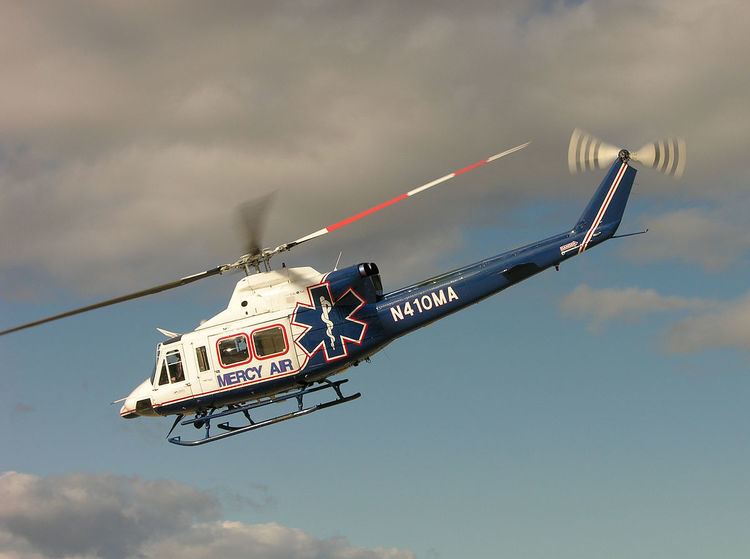 | ||
The safety of emergency medical services flights has become a topic of public interest in the United States, with the expansion of emergency medical services aviation operations, such as air ambulance and MEDEVAC, and the increasing frequency of related accidents.
Contents
Background
Emergency medical services (EMS) aviation operations (conducted with either helicopters or fixed-wing aircraft) provide an important service to the public by transporting seriously ill patients or donor organs to emergency care facilities. The pressure to safely and quickly conduct these operations in various environmental conditions (for example, inclement weather, at night, and unfamiliar landing sites for helicopter operations) makes EMS operations inherently dangerous, and the hazards associated with EMS operations are resulting in an increasing number of accidents. The U.S. National Transportation Safety Board (NTSB) conducted a special investigation and issued a report on January 25, 2006 titled: "Special Investigation Report on Emergency Medical Services Operations". The report was not intended to burden operators with undue requirements or to handicap this vital function in any way; rather the purpose of the report was to identify and recommend operational strategies and technologies that will help ensure that these vital EMS flights arrive safely and continue to provide a valuable service to the public.
Between January 2002 and January 2005, 55 EMS aircraft accidents occurred in the United States1 (this number of EMS accidents had not been seen since the 1980s)2 these accidents resulted in 54 fatalities and 18 serious injuries (see appendix B of the report for more information). Although the number of flight hours flown by EMS helicopter operations in the United States has increased from about 162,000 in 1991 to an estimated 300,000 in 2005,3 the average accident rate has also increased from 3.53 accidents per 100,000 flight hours between 1992 and 2001 to 4.56 accidents per 100,000 flight hours between 1997 and 2001.4 As a result, the National Transportation Safety Board initiated a special investigation of these 55 accidents and identified the following recurring safety issues:
Examples
Of the 55 accidents that occurred between January 2002 and January 2005, the following seven were considered by the NTSB to provide the best examples of the safety issues involved:
These seven accidents were specifically cited, where applicable, in the report’s discussion of each safety issue. More detailed flight histories, as well as probable cause statements for these accidents, were provided in appendix A of the report.
In 2008, midair collisions of emergency flights caused the deaths of 28 crew members and patients.
Previous NTSB study
The Safety Board examined similar safety issues after the occurrence of 59 EMS accidents between May 1978 and December 1986 and concluded in a 1988 safety study5 that many areas of EMS operations needed improvement, including weather forecasting, operations during instrument meteorological conditions (IMC), personnel training requirements, design standards, crashworthiness, and EMS operations management. As a result of its findings, the Board issued 19 safety recommendations to the U.S. Federal Aviation Administration (FAA) and others, which have since been closed (see the report appendix G information about these recommendations and their classifications).
Most of the recommendations to the FAA were closed as a result of the June 20, 1991, issuance of Advisory Circular (AC) 135-14A, "Emergency Medical Services/Helicopter (EMS/H)," which addressed equipment, training, crew resource management (CRM), decision-making, flight-following procedures, weather minimums, and the development of safety programs for EMS helicopter flights operating under 14 Code of Federal Regulations (CFR) Part 135. Although the Safety Board expressed concern at the time that the FAA chose to issue an AC instead of regulations, the number of EMS accidents was decreasing, thus the recommendations were closed.6
Despite the guidance provided in AC 135-14A and AC 135-15, EMS aircraft accidents have continued to occur in significant numbers (as shown in table 1 from the report below) for the 15-year period from 1990 to 2005.
Other studies
Recent industry publications regarding the safety of EMS aviation operations are consistent with the Safety Board’s findings. For example, after an extensive 2-year safety review and risk assessment of helicopter EMS accidents, the Air Medical Physician Association (AMPA) reported in November 2002 that the time of day that flights occur could contribute to accidents.7 The report indicated that even though 38 percent of all helicopter EMS flights occur at night, 49 percent of accidents during a 20-year period occurred during nighttime hours. The report also cited controlled flight into terrain (CFIT), in particular during the takeoff or landing sequence, as a common problem, as well as collision with objects (wires were the most common obstacles for EMS helicopters); inaccurate weather forecasts (about 26 percent of helicopter EMS accidents were weather-related, with most occurring because of reduced visibility and IMC while the helicopter was en route); and communications problems with air traffic control (ATC) or a lack of communications due to remote locations and high terrain.
AMPA’s report also cited time pressures related to the patient’s condition, rapid mission preparation, flight to the patient pick-up location, and low fuel as frequent issues in EMS aircraft accidents. According to a query of the National Aeronautics and Space Administration’s Aviation Safety Reporting System, patient condition was cited in 44 percent of the EMS accidents or incidents reports as a contributor to time pressure leading to inaccurate or hurried preflight planning. In addition, the AMPA report stated that accidents occurred more often when flight crews were en route to pick up a patient than at any other time during flight. A white paper8 published by Helicopter Association International in August 2005 examined many of the same issues as AMPA.
Steps taken
On October 7, 2010, the FAA proposed new warning systems and increased training for emergency medical flights to deal with the spate of recent crashes.
